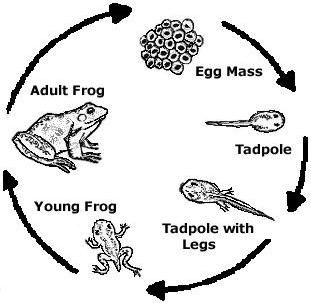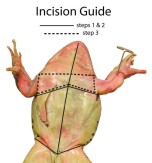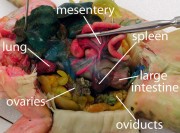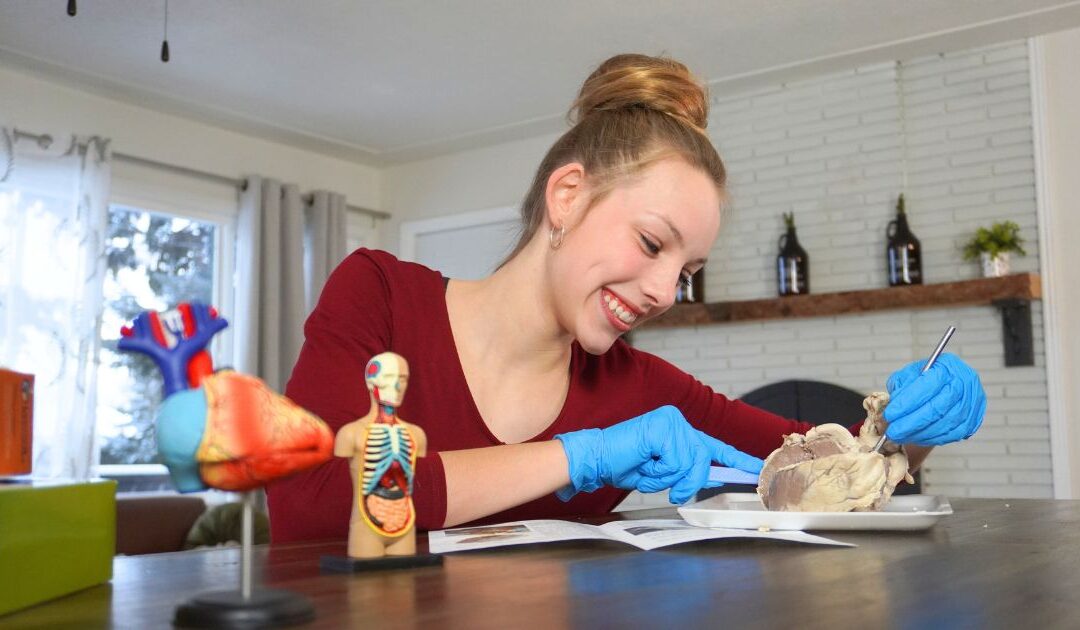Why do we dissect frogs? As it turns out, a frog dissection, like other complex animal dissections, reveals enough about how our bodies work to be valuable. They’re also practical, too.
Frog dissection is cheaper to conduct than larger animal and organ dissections. They’re smaller animals (requiring less manual dexterity) and can be raised quickly for laboratory work.
Download: Frog Dissection Lab
Introduction to Frogs
Frogs are animals that belong to the class Amphibia, commonly known as amphibians.
Amphibians live both on land and in the water; sometimes they live in water only before they are fully grown. They have moist skin that water can pass in and out of, and most of them spend part of their life (in the tadpole-like larva stage before they mature) in the water. The name Amphibian means literally ‘both life.’
There are three orders of amphibians: frogs and toads with over 2,000 species, salamanders (including newts) with approximately 300 species, and caecilians with about 160 species.
What makes frogs different from other amphibians? They have smooth skin, are usually tailless as adults, and have the ability to leap.
Some frogs are aquatic, spending most of their time in the water. Others are terrestrial, staying mostly on land or in trees. (Toads are also tailless, leaping amphibians, but they usually have rough, warty skin.)
Frogs range in size from less than 0.5 inches to 12 inches long!
Frog Science Lesson
Frog Life Cycle

The lifecycle of a frog begins with a fertilized egg. The female frog usually lays eggs in water in a string or mass that sticks to vegetation. The male frog fertilizes the eggs as they are laid. The outer layer of a fertilized egg is a jelly-like material that swells in water, forming a protective coating. The fertilized egg is a single cell that rapidly divides, again and again, producing new cells that quickly differentiate into the organs of the frog embryo. Within 2 to 25 days, depending on water temperature, the egg hatches into a tadpole. The tadpole looks more like a fish at first than like a frog. As the tadpole develops, it forms gills that allow it to breathe efficiently underwater. Its tail grows longer and a fin forms, which allows the tadpole to swim effectively.
The tadpole continues to swim, eat and grow for several weeks before it matures to the next stage. The first sign of further development is the appearance of hind legs. Then front legs develop and the tail becomes shorter as it is resorbed. Internally, the tadpole’s gills are replaced with lungs until finally, the tadpole has become a frog. The young frog grows and matures to adulthood over a period of 2-4 years. The adult frogs then lay their eggs and begin the cycle again.
Anatomy of Adult Frogs
Some frogs are able to leap 20 times their body length! Their front legs are short and specially designed to absorb the impact of landing. Their muscular back legs also work well for swimming. Aquatic frogs have webbed rear feet, usually with five toes. Their front feet are not webbed and usually have four toes. Tree frogs have suction cups on their toes that allow them to cling to the bark of trees.
Frogs have large, bulging eyes that rotate in their socket, providing sight in almost any direction. Their nostrils are located on the top of the head to allow breathing while most of the head is submerged. Although frogs have a good sense of hearing, they don’t have typical external ears. Instead, frogs have a tympanic membrane behind each eye. These pick up sound waves and carry them into their internal ears. Frogs’ tongues are usually long and sticky and designed to be flicked out quickly to catch insects and other prey.
Frogs have skin that is specially designed to protect them from their enemies and to protect them from drying out. To hide from their enemies, frogs have camouflage skin colorings that help them to blend in with their surroundings. Special pigment cells in their skin control the camouflage pattern and colors. Also, some frogs have serous glands in their skin, which secrete a poison that will irritate the mouth of their predators. South American tree frogs secrete a deadly poison, but most are just irritating to humans. To help them keep from drying out, frogs have mucous glands that secrete a waterproof coating to keep their skin moist and slippery.
Have you ever wondered how frogs breathe? When underwater, frogs get their oxygen from water that passes through their skin. Capillaries take the oxygen from the skin into the bloodstream. On land, frogs usually get oxygen by taking air through their throats into sac-like lungs. Frog hearts have three chambers.
To find out more about frogs, do research on one of these topics: what kinds of frogs live in your area? Can you find more than one species of tadpole locally? If so, compare them. What do local frogs eat? How would the mosquito population be affected if there were few or no frogs in a swampy region? Pick a frog or frog characteristic that is interesting to you, and see what you can find out about it. Look for close-up frog pictures in a magazine like National Geographic or on a website.
Frog Dissection Guide
One of the best ways to learn about adult amphibian anatomy is to dissect a preserved frog and see how all the organs fit together inside its body. Use this guide for complete instructions.
Watch this video to get started!
What You’ll Need
You can get a convenient frog dissection kit, or collect the following items:
Frog External Anatomy – Observation Guide
Look carefully at the preserved frog. Notice its powerful hind legs for jumping. The hind legs have five webbed digits (toes), while the front legs have four digits without webbing. Observe that the frog’s skin is colored and spotted to help camouflage it. This coloring can change and is controlled by pigment cells in the skin called chromatophores. At the base of the frog’s back, locate the anus, which is the opening from which waste, eggs, and sperm are discharged.
On the frog’s head, observe the large, bulging eyes that rotate to allow sight in many directions. Frogs don’t have external ears, but just behind each eye is a round, flat membrane called a tympanum (eardrum) that senses sound waves. The tympanum on females is similar in size to the eye but much larger on males. Look for the nostrils (external nares) in front of the eyes, then open the frog’s mouth to see the internal opening of the nostrils (internal nares). (Cut the hinge joints of the mouth with scissors to make it easier to open.) Near the internal nares are two vomerine teeth on the roof of the mouth. Rub your finger along the rim of the upper jaw to feel the tiny maxillary teeth. Male frogs have openings to the vocal sacs near the hinges of the lower jaw.
Frog Internal Anatomy – Dissection Guide
- Lay the frog on its back, spread out its limbs, and pin them to the tray. Use forceps to lift the skin between the hind legs and make a small incision with a scalpel. Continue the cut up the center of the frog’s body with scissors, being careful to cut through the skin only. Use forceps to hold the skin away from the muscle while you cut, if necessary. Make horizontal incisions just above the legs and just below the arms, then fold the resulting flaps back and pin them. (You may need to use a scalpel to help separate the skin from the muscle underneath as you fold it back.)
- Repeat the incisions as before, this time cutting through the muscle layer to a point just below the arms. Lift the muscle with the forceps to prevent cutting the organs underneath.
- When you reach the area just below the arms, turn your scissors and make horizontal cuts through the hard sternum. Repeat the horizontal cuts just above the arms, and then remove the bony strips entirely. Pin the remaining muscle flaps back, just as with the skin.
- Look into the body cavity. The yellow finger-like projections on the sides are the fat bodies. It may be necessary to remove some of these in order to see the organs clearly. Likewise, a female specimen may have well-developed eggs filling the body cavity and obscuring the organs. Remove them as necessary.
Now identify the major organs:
Use this printable diagram as a guide for locating them.
Heart. The frog’s heart is the small triangular organ at the top. Unlike a mammal heart, it only has three chambers — two atria at the top and one ventricle below. Carefully cut away the pericardium, the thin membrane surrounding the heart. Notice the arteries connected to the top of the heart, giving it a ‘Y’ shape.
Liver. Just below the heart, the three-lobed liver is the largest organ in the frog’s body.
Gall Bladder. Lift up the lobes of the liver to find the small greenish-brown sac of the gall bladder nestled between them. This stores bile produced by the liver.
Lungs. Again, lift the lobes of the liver to locate the lungs on either side of the heart. They are made of a spongy tissue.
Stomach. Curving below the liver is the stomach; it looks like a large whitish tube. After identifying the other organs, you can open the stomach and see what the frog ate. (Frogs swallow their food whole.)
Small Intestine. The stomach connects to the small intestine. The first section, or duodenum, is fairly straight, but the rest of the intestine is coiled and held in place by a blood-vessel-filled membrane called the mesentery.
Pancreas. The pancreas is a thin, flat, ribbon-like organ that lies between the stomach and the small intestine.
Large Intestine. The small intestine narrows to the point where it meets the shorter, broader large intestine. This opens into a chamber called the cloaca, the last stop before wastes exit the body through the cloacal opening, or anus. The frog’s sperm or eggs also exit through the cloaca.
Spleen. Lift the small intestine to find the round, reddish spleen attached to the mesentery on the underside. The spleen stores blood as part of the circulatory system.
Ovaries. Female frogs have ovaries full of dark-colored eggs; if the eggs are well-developed, the ovaries will be very large and visible. If not, lift the stomach and intestines to see the ovaries beneath them.
Oviducts. Move the ovaries to one side to see the coiled tubes of the oviducts. If the eggs in the ovaries are not fully developed, the oviducts will be small and tightly coiled.
Kidneys. The kidneys are flat, oval-shaped organs on the back wall of the body cavity beneath the ovaries.
Testes. Male frogs have bean-shaped testes attached to their kidneys.
When you’re done, print out this diagram and fill in the labels yourself to test your knowledge of frog anatomy:
Think you’re ready to dissect something a little bigger? Sheep are a great next step up. Check out our sheep dissection specimens below to continue your dissection journey and exploration!







